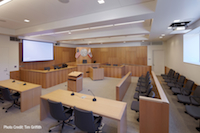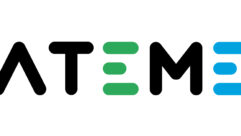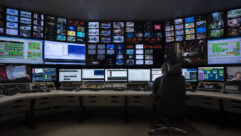

InfoComm International Forms Independent Technical Service Providers Council
Nov 28, 2011 3:51 PM
The California courts apply InfoComm standards to every courthouse in the state.
The InfoComm International Board of Directors has approved the creation of an Independent Technical Service Providers Council, a new group with the objective of promoting the role of independent technical service providers (ITSP) for outsourced integration and event project work. The council also gives the independent technical service providers a collective voice with hardware and software vendors.
“InfoComm International is pleased to support this growing segment of the AV industry,” said Duffy Wilbert, CTS, CAE, Senior Vice President of Membership, InfoComm International.
Along with the approval of the council, the InfoComm Leadership Development Committee appointed Mark DelGuidice, CTS, owner of Wire Wizards Integration in San Diego, as the Council Chair. DelGuidice led the effort to form the new council.
“I wanted to create a home for this particular segment of InfoComm members” said DelGuidice. “These professionals fill a specific role that differs from those of traditional integration, rental, staging or distributor organizations.”
The Independent Technical Service Providers Council will hold its first formal meeting in November. Members who would like to participate in this council should contact the InfoComm staff liaison Marc Bialek at [email protected].
The ITSP Council is one of nine InfoComm councils representing industry segments, including: the Independent Consultants in Audiovisual Technology (ICAT) Council; the Independent Programmers Council; the Independent Reps Council; the Manufacturers Council; the Rental & Staging Council; the Systems Integration Leadership Council (SILC); the Technology Managers Council; and the European Council.
InfoComm Works to Protect the Meetings Industry
When business meetings and events are cancelled, it is often the hourly-wage workers who pay the highest price. Generating one million jobs and $27 billion in wages in the U.S. alone, meetings and events represent an important part of the U.S. economy.
InfoComm International has been working with a variety of coalitions to convince policymakers to tone down the dangerous rhetoric leading to the cancellation of meetings and events around the country; to embrace sensible guidelines for companies receiving taxpayer assistance; and to promote travel as an economic solution. InfoComm has joined U.S. Travel and other partner associations to achieve these goals through the launch of the Meetings Mean Business campaign in March 2009. The Meetings Mean Business campaign has utilized grassroots mobilization, paid advertising, new media strategies and breakthrough research to help policymakers, the media and the public understand the value of meetings and events and the one million jobs they support.
In addition, InfoComm is working with the American Society of Association Executives to preserve the right of non-profit organizations that lobby to host widely attended events with government employees. Currently, the Obama administration is considering implementing this restriction, which would have negative impacts on groups that host trade shows, training events and conferences.
InfoComm is also supporting The International Association of Exhibitions & Events (IAEE) new public relations campaign promoting the value of face-to-face meetings. This three-year program, kicking off in December, is the largest strategic initiative ever conducted by IAEE. The campaign will be conducted by Edelman Public Relations.
NFPA 72-2010 and Its Implications for the AV Industry
InfoComm International has developed a white paper on NFPA 72-2010 and its impact on the audiovisual industry. Building codes have existed for almost 4,000 years. To this day, building and safety codes dictate construction practices. But codes have only become high priority for AV professionals over the last 50 years, as AV equipment migrated from the movable rolling cart to permanent installation in public and private buildings.
Fire detection and prevention also has a long history. But the intersection of building codes with fire detection and AV equipment is a much more recent trend. For years, fire alarm notification was limited to bells, horns, and telegraph messages. Only in the latter half of the 20th century have we seen the use of visible notification devices and commercial loudspeakers in fire-alarm notification systems. Even then, these devices have been primarily special-purpose devices such as strobe lights and low-fidelity (but very loud) loudspeakers or combination devices.
The requirements for use of these devices, along with all other elements of a fire alarm system, were assembled in a collection of documents which eventually became the National Fire Alarm Code (or NFPA 72), first published by the National Fire Protection Association in 1993. But it wasn’t until the most recent revision of NFPA 72 that code-compliant commercial/professional-grade audio systems and video displays were recognized as legitimate components of an emergency communications system.
The 2010 edition of NFPA 72 has been called the most significant revision of the National Fire Alarm Code since its creation. Among the changes in the 2010 edition is a new emphasis on the design, installation and performance characteristics of audio and video components and systems. Many areas of expertise we normally associate with audiovisual professionals are now clearly linked with the life-safety and construction industries.
Adoption of the revised code is still in the very early stages. The “inter-industry” exposure that this code revision represents will likely result in increased opportunities for AV professionals. Taking advantage of such opportunities requires knowledge of the relevant revisions. This InfoComm International white paper reviews the important new changes to NFPA 72 as a result of the 2010 revision, and the potential implications for the AV communication industry. To read the white paper please visit www.infocomm.org.
InfoComm International Forms Independent Technical Service Providers Council
Nov 28, 2011 3:51 PM
How the California Courts Apply InfoComm Standards to Every Courthouse in the State
InfoComm’s Brad Grimes has prepared a special report on how California courts are applying InfoComm standards. If you dig into the most recent facilities standards for California’s trial courts — somewhere between mandatory provisions for conference and training rooms and fire protection criteria — you will find a section devoted to courthouse audiovisual systems. And in the section on AV systems, you’ll find descriptions such as the following: “Speech and audio reinforcement systems design shall follow the current release of the design standards established by ANSI/INFOCOMM 1M-2009 Audio Coverage Uniformity in Enclosed Listener Areas (ACU).”
In fact, the current version of the California Trial Court Facilities Standards, published by the Judicial Council of California’s Administrative Office of the Courts and due to be final in November 2011, makes reference to all three existing ANSI/INFOCOMM standards, including 2M-2010 Standard Guide for Audiovisual Systems Design and Coordination Processes and 3M-2011 Projected Image Contrast Ratio standards.
“It’s important to have the standards in there,” says Jennifer Willard, CTS, Supervising AV/Video Systems Technical Analyst with California’s Administrative Office of the Courts. “When you talk about courthouses, architects design fabulous buildings, but they can prove difficult for integrating proper audiovisual systems. The standards are critical because they hold the architects and designers accountable. Now we’re not forced to compromise on our AV systems. Thanks to the standards, we’ve finally got something that, from a performance perspective, we can leverage to our advantage.”
And in the California courts, that’s no small deal. Under California Senate Bill 1407, 41 courthouses in the state are slated to be built or renovated through 2015, at a cost of roughly $5 billion. Although the latest version of the courts standards hasn’t been finalized (the prior version was published in 2006, when AV systems were still predominantly analog), Willard says some designers are already working in the spirit of the pending document and with an eye toward the InfoComm standards.
“This is a milestone,” Willard says. “AV was included under telecommunications in the 2006 edition of the courts standards. For the first time ever, AV technology has its own chapter.”
Read the complete article at infocomm.org.










